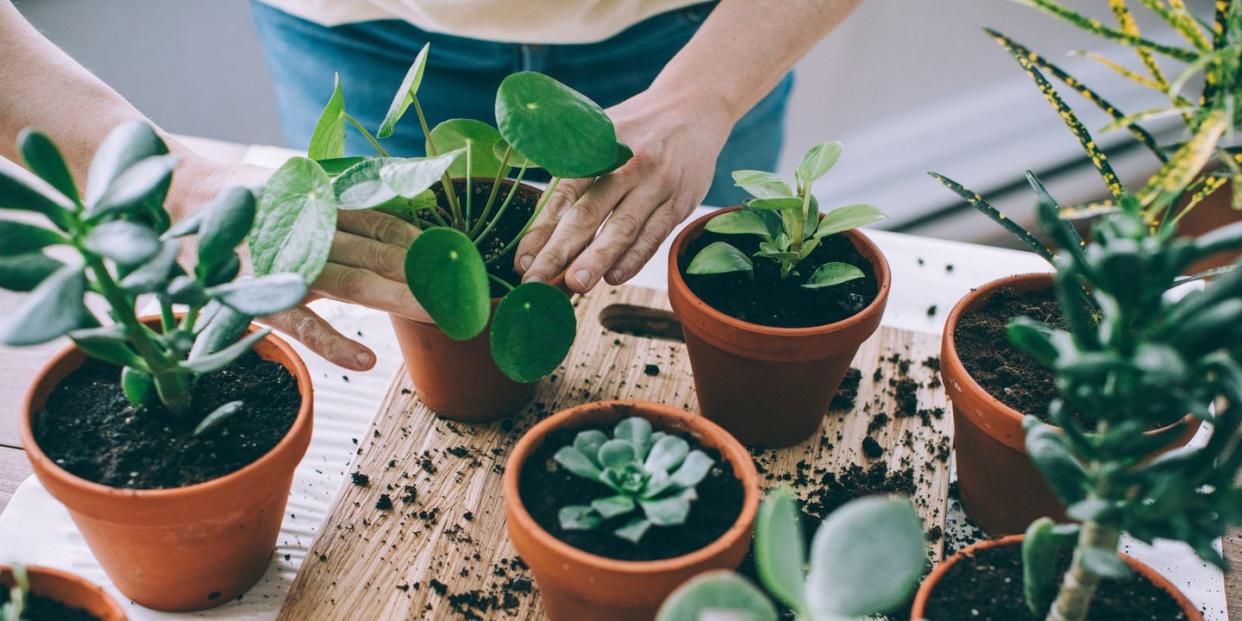How to Propagate Houseplants

"Hearst Magazines and Yahoo may earn commission or revenue on some items through the links below."
Your home may already be overflowing with houseplants, but there’s always room for one more! Fortunately, many houseplants can be easily propagated using a few basic techniques. “Propagating houseplants is a great way to increase the number of plants you have and to share or swap plants with others,” says Lisa Eldred Steinkopf, author of Bloom: The Secrets of Growing Flowering Houseplants Year-Round. “It’s also a way to make sure you preserve a plant that has sentimental ties, such as your Grandma’s Christmas cactus that’s been handed down to you.”
It’s best to propagate when the plant is actively growing, which is generally from spring to fall. Some houseplants can be propagated by division, such as ferns, cast iron plants, peace lilies, and some types of philodendron. You can take the plant out of the pot and tease the roots apart with your fingers; it’s fine to cut through some roots if you must, too. Spider plants are even easier. They develop babies, called pups, which you can snip off and plant directly into new soil to get a new plant.
For other houseplants, there are a few different methods for propagating, and certain techniques work better for certain plants. Sometimes it's a matter of trial and error but overall, it’s easy to do and you don’t need a lot of fancy tools or knowledge to make it happen, says Steinkopf. Some plants actually root just fine from cuttings placed in water. Otherwise, you’ll need clean potting soil or a soilless potting medium like vermiculite (some people say it's better for rooting new plants, but it's not always necessary), a sharp knife, and rooting hormone, which is nice to have on hand for helping fussier plants root more easily.
Here’s what you need to know about how to propagate houseplants:
How do I root a plant in water?
It couldn’t be easier to root many houseplants in plain old water. Snip off a piece a few inches long with three or four leaves from the end of the plant. Put the cut end of the stem in a glass of water, making sure no leaves are submerged. Place the cutting in bright, indirect light (not direct sunlight) and wait. Change the water every few days.
When roots form after about 10 days, pot your new baby plant with fresh potting soil. This technique works best for plants such as pothos, aglaonemas, rubber plants, English ivy, heartleaf philodendrons, spider plants, and begonias.
How do I use rooting hormone?
Some plants such as African violets, peperomias, and some succulents do better when you use rooting hormone to jumpstart the process. Start with a stem cutting, as above, or a leaf cutting, which is when you take one leaf and its tiny leaf stem, called a petiole. Dip the stem or petiole end into water, then the rooting hormone, shaking off any excess. Make a hole in the potting medium, place the cutting in the hole and try to keep it upright (sometimes you can lean it against the side of the pot, stake it, or crumple up foil to give it some support). Keep the rooting medium moist but not soaking wet while waiting for cuttings to root. In a few weeks, you'll know the cutting has rooted if you feel resistance when you tug slightly on the plant.
How can I propagate a snake plant?
Snake plants are also easy to propagate, though you should use a different method for best results. Use a sharp knife to cut off a single leaf. Cut the leaf into 2- to 3-inch-long sections, paying attention to which end is the bottom (that’s the end that must be planted). Insert it into the rooting medium, then pop it into your potting soil or soilless potting medium, and wait. If that seems like too much work, you can put the whole leaf into the soil. For either method, wait a few days to water your plant, then water it sparingly because snake plants have fleshy leaves and will rot if you water them too often.
How can I propagate a succulent?
It’s so easy! Pull off a leaf, let it dry out for a few days, then leave it on top of the soil in bright, indirect light. Let the piece develop roots, then tuck it into the soil. For succulents that vine, such as string of pearl plants, simply snip off a piece and tuck it anywhere else in the pot (which also helps make a fuller plant). The bottom line is: Give propagating new houseplants a try! You have nothing to lose, and you might just gain a whole bunch of new plant babies.
You Might Also Like

